Golf Chipping Technique & Tips [The Ultimate Guide] – Golf Insider UK
In this article we’re going to dive into detail to help you build an awesome short game. This is an advanced guide on chipping technique, detailing the chipping tips you’ll need to get to a scratch standard or better. If you are looking for a simpler, beginner friendly guide check out our how to chip article.
We’ll first cover some basic concepts before showing you how they relate to your chipping technique. The aim of great chipping is to consistently hit your ball accurately towards your target, with the correct distance.
To achieve this you need to build a chipping action that creates the following:
- Consistent launch angle
- Consistent launch velocity
- Consistent spin
You can see the key word here is consistent – we want every chip shot to leave your club face with the same flight. You can then change your club or tweak your setup to hit any shot you require.
The fundamentals of great chipping
The golf ball only cares about impact, so to achieve the outcomes above we need to control the following variables:
- Centred strike
- Low point
- Angle of attack
- Dynamic loft
- Spin loft
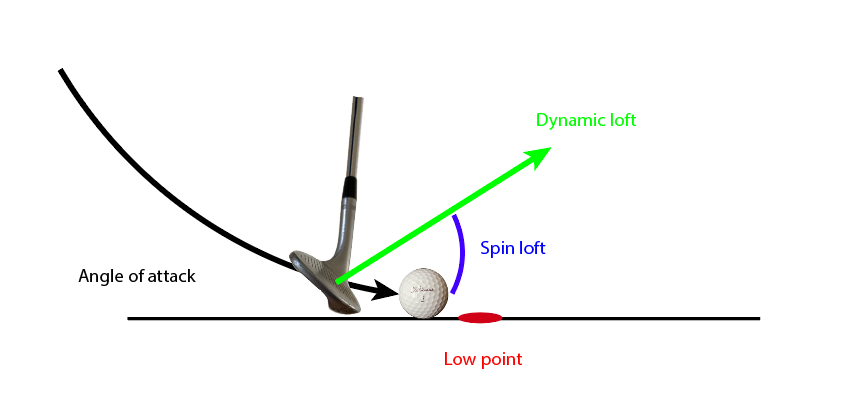
Above we have a diagram explaining these concepts. Assume these are all occurring at the moment of impact, I’ve stretched impact out a little to make the graphic clearer.
- Angle of attack is the angle the club head is approaching the ground.
- Low point is the bottom of your swing arc in relation to the ball, usually just ahead of the ball.
- Dynamic loft is the loft on the club face at impact, usually less than the loft at address.
- Spin loft is the difference between the dynamic loft and the angle of attack.
Below we have a second graphic to explain centeredness of strike. Most golfers are well aware they should hit the middle of the grooves between the heel and toe, but we also need to consider how high up the club face the ball impacts. Your low point, angle of attack, dynamic loft and the lie of the golf ball can all affect this variable.
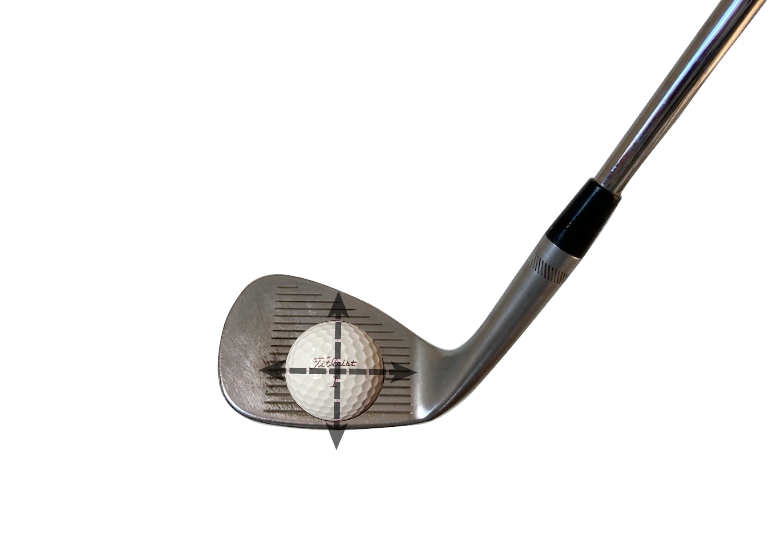
Golf chipping technique
What follows is my preferred approach for hitting a standard chip shot. I will do my best to explain the why behind each point. We’ll see at the end of this article, you can be playful with how you build your own perfect technique.
Setup for chipping
The aim of a great setup is to make creating a great impact position as simple as possible and allow things to move freely when chipping. At impact we’re looking to create a slightly descending angle of attack with the low point just ahead of the golf ball.
To help achieve this we can place a 60% of our weight through our front foot and position the ball in the centre of your stance. You can vary your ball position to anywhere within the yellow shaded area, but the setup described here makes it very easy to create a descending strike and low point just ahead of the ball.
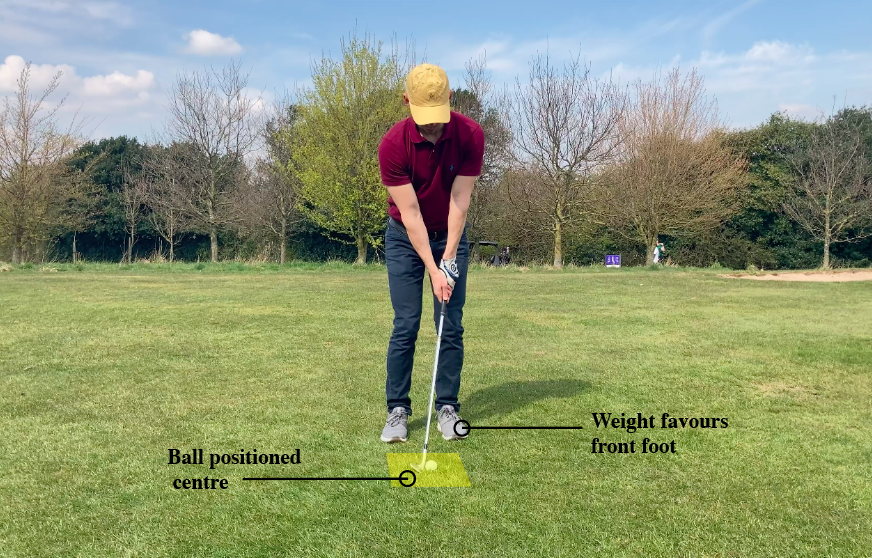
Your stance width should be narrower than a full shot. The wider your stance, the harder it is to rotate your lower body back and through, some lower body rotation is ideal, as it add momentum to your pivot back and through.
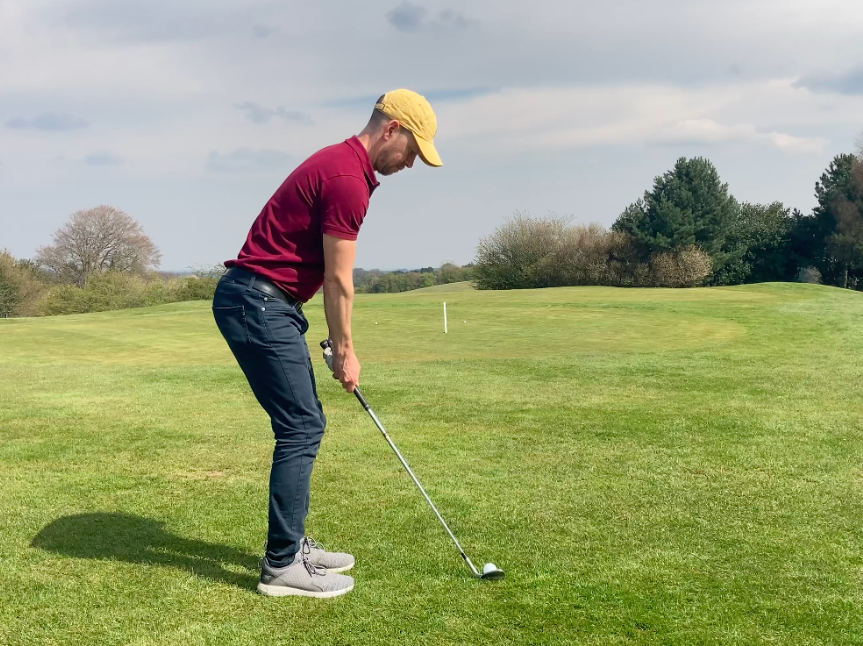
Two small further tips are – to keep a neutral spine angle at setup (not hunched), this allows your thoracic spine to rotate freely during your swing. Secondly, you can grip down the golf club (optional and not shown above) – the shorter lever gives you more control and allows you to make a more positive chipping action. I tend to use this approach when chipping with PW, 9-irons and 8-irons, but less so with SW and LW.
Chipping backswing
Your backswing is a combination of body pivot, arm swing and wrist hinge. You have a fair amount of choice with how much you use of each. More body pivot and less wrists results in a wider, shallower arc with less stored power. This will create lofted wedge shots that pop up high.
In contrast, more wrists and less body turn results in a steeper arc and more stored power. This will create a steeper angle of attack, often with more spin loft – resulting in lower flighted chip shots with more spin.
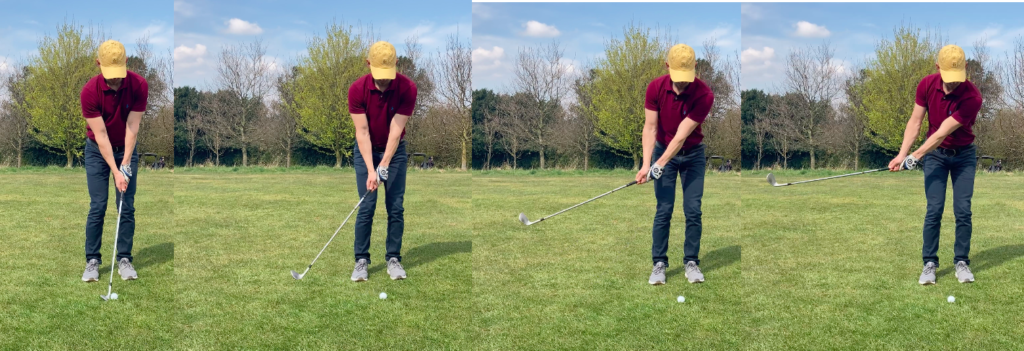 Notice the action above has some body turn, the right arm folds and the wrists have a little hinge.
Notice the action above has some body turn, the right arm folds and the wrists have a little hinge.
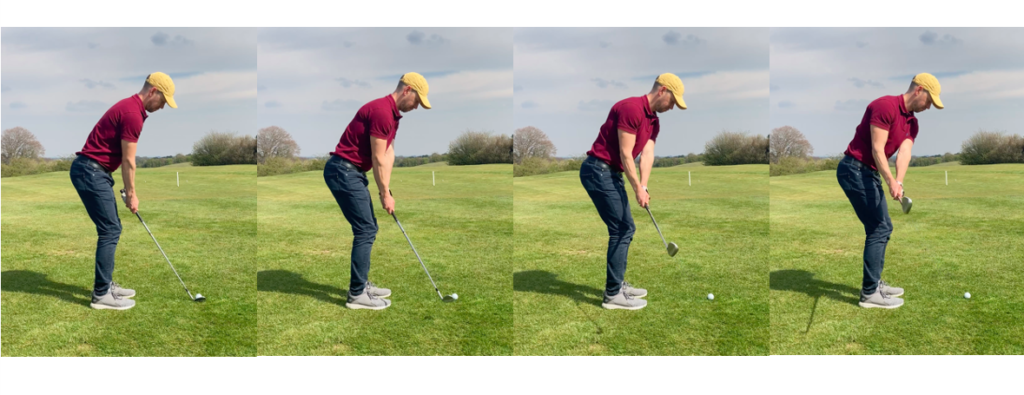 From the sequence above you can see the arms and club travel on an arc around your body.
From the sequence above you can see the arms and club travel on an arc around your body.
Chipping tips for your backswing
As I mentioned earlier, you can have a play around with how much body turn, arms and hinge you create during your backswing. Try hitting chips shots will all body turn and no wrists, then try with no body action and all wrists. Finally, just let your arm roll back and through to hit chip shots. This simple drill will soon give you an idea of how each affects impact and the chip shots you can create.
Despite the playful approach above there are a couple of key features I would suggest you implement to become a great chipper.
Mục Lục
Stable head position
If you check the head position on both sequences above you’ve notice it hardly moves. Many golfers who struggle with their chipping have a little movement during their backswing. 1-2 inches of movement may not look like much, but you’ve now altered your low point, centredness of strike and angle of attack considerably.
Right arm action
Another quick tip is to make a chipping backswing without a club and check your right palm faces out in front of your as you end your backswing. This move allows you to keep the club on a shallow arc, it also keeps the natural loft on the club and makes it easier to use the bounce (sole of the club) correctly.
Chipping downswing
Your downswing should be pretty instinctive, aiming to gather the golf ball as you turn through towards your target. Here are a couple of key notes:
The body and chest rotate towards the target and everything else follows. To me it feels like the chest, arms and club all move through as one unit, but the screen shots suggest the body leads fractionally (feel vs reality).
Also, notice how the posture angles are maintained till well after impact but the head freely rotates, almost following the golf ball to the target. Maintaining your posture angles helps to ensure you will strike the centre of the face and keeps the low point in your swing arc where you intended it to be.
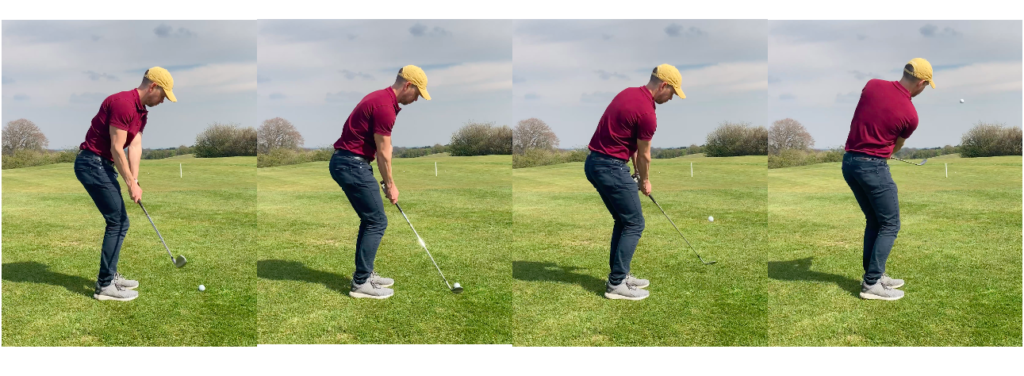
Keeping your looking down head down, and not rotating, is probably the biggest myth in chipping. Yes, you want to stay in posture, but allowing your head to turn through encourages great body action!
See the sequence below.
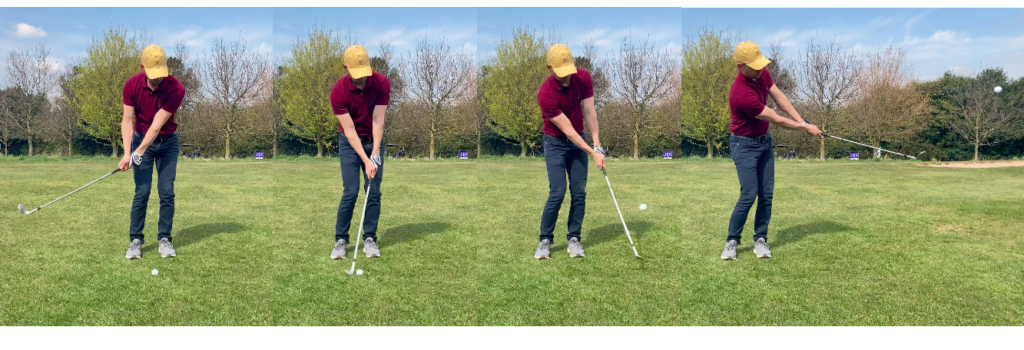
If you are good at chipping but wish to become exceptional please take note of the image and section below. Here we’ll make some important links back to our impact factors for great chipping.
Lead arm & shaft angle
In the image below we are six inches post impact, but notice how there is still a straight line between the lead arm and club shaft. This position creates a wide window through impact were the loft on your club (dynamic loft) stays consistent. Many golfers have a small amount of left wrist extension at this point – 4-5º may not sound like a lot but it means you’ve suddenly turned your sand wedge into a lob wedge. The result is variable launch conditions and distance control when chipping.
Minimal wrist action through impact also prevents any unwanted club head acceleration and keeps your angle of attack and spin loft consistent. Besides impact itself I feel this position below is the most important to master if you wish to be great at chipping.
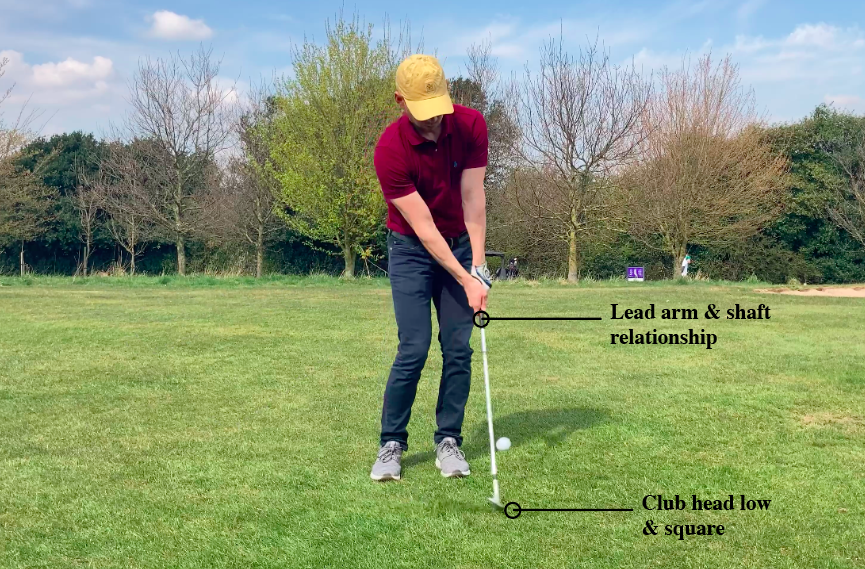
Club face square to target
At the bottom of the image we can see that the club face is still square to our target. This helps with direction, but again stabilises the dynamic loft through impact. As soon as the club face begins to close, your 56º wedge quickly moves to 52/53º and, as a result, your distance control will suffer.
If you want to work on keeping your club face square for longer it can be helpful to think about keeping the badge on your glove pointing towards your target for as long as you can through impact.
Finally, a quick note for anyone still trying to help the ball up in the air when chipping. Notice how low the club head is to the ground, almost underneath the golf ball at this point. No one needs to help the ball up into the air, instead focus on brushing the grass, making solid contact and let the loft on the club do the work.
Swing thoughts for chipping
If you’re struggling with consistent contact when chipping, focus on brushing the grass under the ball with your club, or moving the club head through through impact nice and low. Both of these ideas have worked well when coaching players over the years.
For higher level players wanting to excel around the greens I would check your basics are in place, then focus on mastering impact to post-impact, with firm wrists and keeping the club face square to the target for longer.
Task 1 – Create the same flight and strike for every chip shot
You want to be able to hit 5 chips in a row, with each strike feeling the same, and the ball launching at the same trajectory and going the same distance each time.
This type of basic blocked practice is handy for tweaking your technique, building confidence and making the action feel natural. Once you’re happy, feel free to implement the section below.
How to hit different chip shots
Once you have mastered the tips above you’ll have exceptional levels of consistency. You can now vary some simple parts of your setup to hit different shots with each club. Each variation you create should be highly predictable and easy to judge thanks to your solid chipping fundamentals you have developed above.
Ball position
Start by altering your ball position for a little chip shot. Hit chip shots from your 1) standard setup 2) with the ball further back in your stance and 3) the ball further forward in your stance. All you need to focus on is making a solid impact from this new setup.
Altering your ball position changes your low point, angle of attack and dynamic loft. The result is different launch angles and different amounts of spin. You now have three different variations of chip shot with each club.
Face angle
The second factor to play with is how square, open or closed your club face is when you take your golf grip. Yes, that’s right I said closed. An open club face increases the club’s bounce and gives you more loft to work with. This is great for popping up shots out of the rough.
Closing the club face reduces the bounce, and helps the toe dig down and through an awkward lie. If you have a really bad lie in the rough and a good amount of green to work with this can be a really handy shot.
Using the two dials above (ball position & face angle) you now have many ways to alter the flight and release of your chip shots with each club. It is worth having a little practice with each variation to find out which options create the most consistent results for you.
Always pick the option that will minimise the proximity you have left to the hole over a 10-shot average, as this will optimise your scrambling percentages and your scoring.
Putting it into practice
The best short game players have fun seeing what they can create. Once you’ve mastered the basics grab 3-5 balls and play around with your ball position and face angle.
Here is a short video to show you how altering club face angle and ball position together can create very different shots with the same club. Pay attention to the trajectory and landing these three different set-ups create with a Sand Wedge.
Summarising golf chipping
Great chipping is about controlling the launch of your golf ball. Here we have covered the impact factors that dictate how your ball launches and have explained the basics of chipping technique to help you create the same impact and flight time and time again.
We’ve covered a lot, but hopefully this is a helpful resource to help you develop your short game skills. Make a couple of notes, and see if you can hit 5 identical chip shots in a row. Once you can, try varying your ball position and club face angle to see what other chip shots you can create.
Leave any questions or comments below and check out this article for some great chipping games to test your newfound skills, or this article for a great 4-piece short game practice plan.
If you’d like to master your sand play check out this link on how to hit a bunker shot. If you would like to receive a free article like this one every Monday, come join the Golf Insider weekly post.
Happy golfing – Will @ Golf Insider UK
Head back to the short game hub to keep improving your game.
How useful was this post?
Click on a trophy to rate it!
As you found this article useful…
Would you mind sharing it to help me grow this site?
Sorry that this article was not useful for you.
Would you mind helping me improve this article?















![Toni Kroos là ai? [ sự thật về tiểu sử đầy đủ Toni Kroos ]](https://evbn.org/wp-content/uploads/New-Project-6635-1671934592.jpg)


